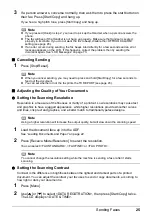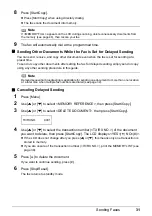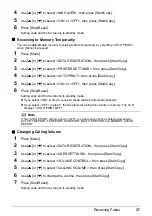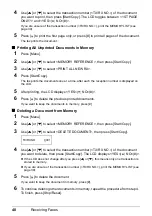
29
Sending Faxes
Redialing When the Line is Busy
There are two methods of redialing: manual redialing and automatic redialing. This section explains
these two methods.
Manual Redialing
Press [Redial] to dial the last number you dialed with the numeric buttons*. (This starts redialing
regardless of whether automatic redialing is enabled.)
*This setting is only available when you dialed with the numeric buttons.
z
Canceling Manual Redialing
To cancel manual redialing, press [Stop/Reset]. You may then need to press [Start/Copy] for a
few seconds to feed out the document. See “Jams in the ADF” on page 60.
Automatic Redialing
z
What is Automatic Redialing?
When you are sending a document and the receiving party’s line is busy, the fax waits the
specified time and then dials the same number again. You can set the fax to redial several times
if previous attempts fail because of a busy signal.
Automatic redialing can be turned off and on. The number of redialing attempts and the time
interval between attempts can also be adjusted (see page 46).
If all redialing attempts are unsuccessful, the fax will cancel the transmission. You can set the fax
to print the ERROR TX REPORT to remind you that the transmission was not completed (see
page 45).
When automatic redialing is in use, the LCD displays <AUTO REDIAL> while it is waiting to
redial.
z
Canceling Automatic Redialing
1
Press [Stop/Reset].
z
Setting the Options for Automatic Redialing
You can set the following options for automatic redialing:
z
Whether or not the fax redials automatically.
z
The number of times the fax attempts to redial.
z
The time interval between redialing attempts.
1
Press [Menu].
2
Use [
{
] or [
}
] to select <DATA REGSTRATION>, then press [Start/Copy]. The
LCD displays <USER SETTINGS>.
3
Use [
{
] or [
}
] to select <TX SETTINGS>, then press [Start/Copy]. The LCD
displays <ECM TX>.
Note
If you want to cancel a memory-sending transmission while the fax is waiting to redial, you will
have to delete the document from memory (see page 40).
















































